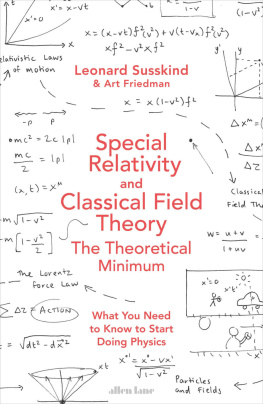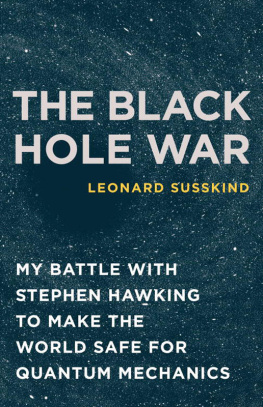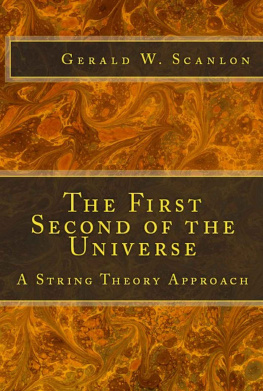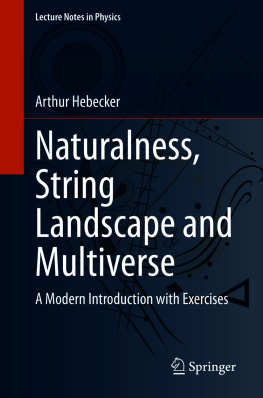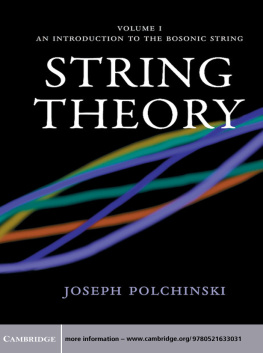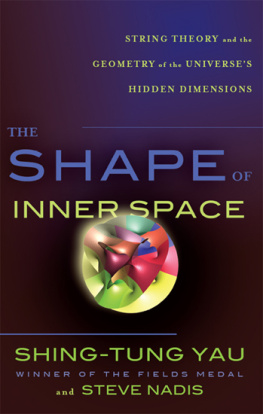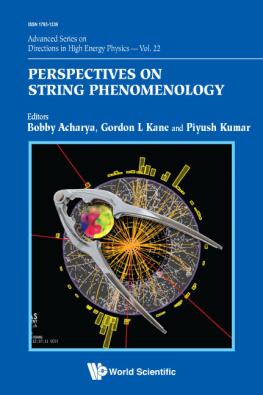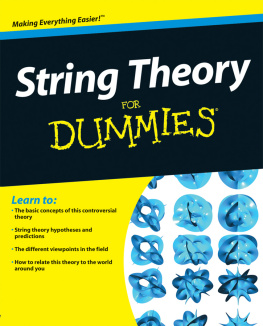Leonard Susskind - The Cosmic Landscape: String Theory and the Illusion of Intelligent Design
Here you can read online Leonard Susskind - The Cosmic Landscape: String Theory and the Illusion of Intelligent Design full text of the book (entire story) in english for free. Download pdf and epub, get meaning, cover and reviews about this ebook. year: 2006, publisher: Back Bay Books, genre: Children. Description of the work, (preface) as well as reviews are available. Best literature library LitArk.com created for fans of good reading and offers a wide selection of genres:
Romance novel
Science fiction
Adventure
Detective
Science
History
Home and family
Prose
Art
Politics
Computer
Non-fiction
Religion
Business
Children
Humor
Choose a favorite category and find really read worthwhile books. Enjoy immersion in the world of imagination, feel the emotions of the characters or learn something new for yourself, make an fascinating discovery.

- Book:The Cosmic Landscape: String Theory and the Illusion of Intelligent Design
- Author:
- Publisher:Back Bay Books
- Genre:
- Year:2006
- Rating:4 / 5
- Favourites:Add to favourites
- Your mark:
- 80
- 1
- 2
- 3
- 4
- 5
The Cosmic Landscape: String Theory and the Illusion of Intelligent Design: summary, description and annotation
We offer to read an annotation, description, summary or preface (depends on what the author of the book "The Cosmic Landscape: String Theory and the Illusion of Intelligent Design" wrote himself). If you haven't found the necessary information about the book — write in the comments, we will try to find it.
The Cosmic Landscape: String Theory and the Illusion of Intelligent Design — read online for free the complete book (whole text) full work
Below is the text of the book, divided by pages. System saving the place of the last page read, allows you to conveniently read the book "The Cosmic Landscape: String Theory and the Illusion of Intelligent Design" online for free, without having to search again every time where you left off. Put a bookmark, and you can go to the page where you finished reading at any time.
Font size:
Interval:
Bookmark:
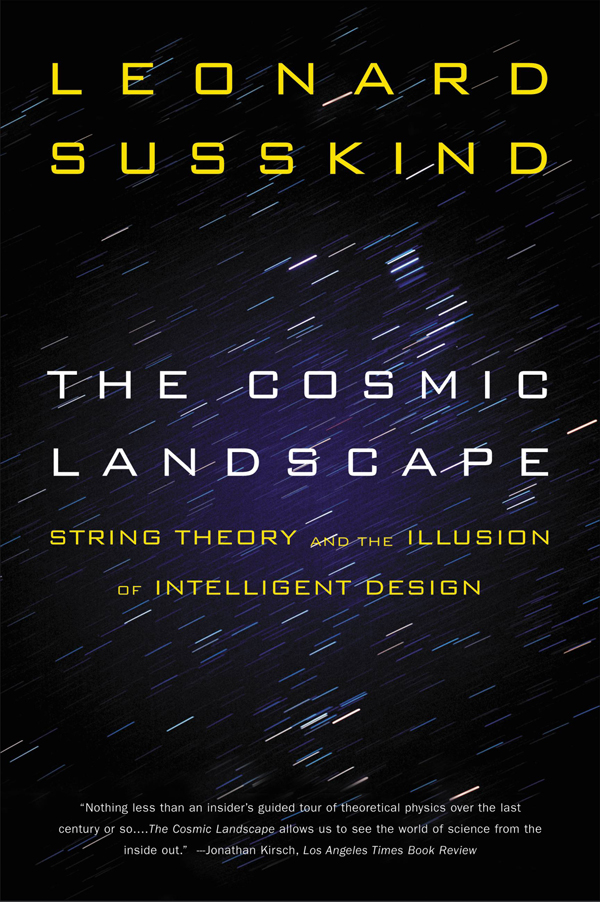
Copyright 2006 by Leonard Susskind
All rights reserved. No part of this book may be reproduced in any form or by any electronic or mechanical means, including information storage and retrieval systems, without permission in writing from the publisher, except by a reviewer who may quote brief passages in a review.
Hachette Book Group
237 Park Avenue, New York, NY 10017
Visit our Web site at www.HachetteBookGroup.com
First eBook Edition: December 2005
Illustration credits: Einstein (p. 70), California Institute of Technology Archives; Rube Goldberg machine (p. 112), Rube Goldberg is the and of Rube Goldberg Inc.; Keplers model (p. 120), from J. Kepler, Mysterium Cosmographicum (1596); Crab Nebula (p. 181), ESOEuropean Southern Observatory; eclipse (p. 188), Fred Esperak; snowflake (p. 242), Kenneth G. Libbrecht, Professor of Physics, Cal Tech; Calabi Yau (p. 290), Jean-Franois Colonna, CMAP (Centre de Mathmatiques Appliques); Mercator projection (p. 311), An Album of Map Projections, USGS Professional Paper 1453, by John P. Snyder and Phillip M. Voxland (USGPO, 1989); Escher (p. 312), M. C. Eschers Limit Circle IV, 2005 The M. C. Escher CompanyHolland. All rights reserved.
ISBN: 978-0-316-05558-1
The Little, Brown and Company name and logo are trademarks of Hachette Book Group, Inc.
I have always enjoyed explaining physics. In fact its more than just enjoyment: I need to explain physics. A lot of my research time is spent daydreamingtelling an imaginary admiring audience of laymen how to understand some difficult scientific idea. I suppose I am a bit of a ham, but its more than that. Its part of the way I think: a mental tool for organizing my ideas and even creating new ways of thinking about problems. So it was natural that at some point I would decide to try my hand at writing a book for a general audience. A couple of years ago I decided to take the plunge and write a book about the twenty-year debate between myself and Stephen Hawking concerning the fate of information that fell into a black hole.
But just about that time, I found myself in the eye of a huge scientific hurricane. The issues involve not only the origin of the universe but also the origin of the laws that govern it. In my scientific article The Anthropic Landscape of String Theory, I called attention to the new emerging concept that I had christened the Landscape. The paper stirred up an enormous fuss in the physics and cosmology communities that by now has spread to philosophers and even theologians. The Landscape represents an idea that cuts across boundaries and touches not only on current paradigm shifts in physics and cosmology, but also on the profound cultural questions that are rocking our social and political landscape: can science explain the extraordinary fact that the universe appears to be uncannily, nay, spectacularly, well designed for our own existence? I decided to put the black hole book on the back burner for the moment and write a popular book about this extraordinary story. Thus was born The Cosmic Landscape.
Some readers of this book will be aware that in the past few years the science sections of newspapers have been reporting that cosmologists are mystified by two astonishing dark discoveries. The first is that 90 percent of the matter in the universe is made of some shadowy, mysterious substance called dark matter. The other is that 70 percent of the energy in the universe is composed of an even more ghostly mysterious stuff called dark energy. The words mystery, mysterious, and mystified get a very thorough workout in these articles.
I have to admit I find neither discovery all that mysterious. To me, the word mystery conveys something that completely eludes rational explanation. The discoveries of dark matter and energy were surprises but not mysteries. Elementary-particle physicists (I am one of them) have always known that their theories were incomplete and that many particles remain to be discovered. The tradition of postulating new, hard-to-detect particles began when Wolfgang Pauli correctly guessed that one form of radioactivity involved an almost invisible particle called the neutrino. Dark matter is not made of neutrinos, but by now physicists have postulated plenty of particles that could easily form the invisible stuff. There is no mystery thereonly the difficulties of identifying and detecting those particles.
Dark energy has more of a claim to being called mysterious, but the mystery has much more to do with its absence than its presence. Physicists have known for seventy-five years or more that there is every reason for space to be filled with dark energy. The mystery is not why dark energy exists but why so little of it exists. But one thing is clear: even a little more dark energy would have been fatal to our own existence.
The real mystery raised by modern cosmology concerns a silent elephant in the room, an elephant, I might add, that has been a huge embarrassment to physicists: why is it that the universe has all of the appearances of having been specially designed just so that life forms like us can exist? This has puzzled scientists and at the same time encouraged those who prefer the false comfort of a creationist myth. The situation in many ways resembles biology before Darwin, when thoughtful people were unable to understand how, without the guiding hand of a deity, natural processes of physics and chemistry could possibly create anything as complex as the human eye. Like the eye, the special properties of the physical universe are so surprisingly fine-tuned that they demand explanation.
Let me be up front and state my own prejudices right here. I thoroughly believe that real science requires explanations that do not involve supernatural agents. I believe that the eye evolved by Darwinian mechanisms. Furthermore, I believe that physicists and cosmologists must also find a natural explanation of our world, including the amazing lucky accidents that conspired to make our own existence possible. I believe that when people substitute magic for rational explanation, they are not doing science no matter how loudly they claim otherwise.
In the past most physicists (including me) have chosen to ignore the elephanteven to deny its existence. They preferred to believe that natures laws follow from some elegant mathematical principle and that the apparent design of the universe is merely a lucky accident. But recent discoveries in astronomy, cosmology, and above all, String Theory have left theoretical physicists little choice but to think about these things. Surprisingly, we may be starting to see the reasons for this pattern of coincidences. Evidence has been accumulating for an explanation of the illusion of intelligent design that depends only on the principles of physics, mathematics, and the laws of large numbers. This is what The Cosmic Landscape is about: the scientific explanation of the apparent miracles of physics and cosmology and its philosophical implications.
Who are the intended readers of this book? The answer is anyone with a lively interest in science and a curiosity about how the world came to be the way it is. But although the book is aimed at a lay audience, it is not aimed at the lightweight who is afraid to stretch his or her mind. I have kept the book free of equations and jargon but not of challenging concepts. I have avoided mathematical formulas, but on the other hand, I have striven to give accurate and clear explanations of the principles and mechanisms that underlie the new emerging paradigm. Understanding this new paradigm will be critical for anyone hoping to follow the further developments in answering the big questions.
Font size:
Interval:
Bookmark:
Similar books «The Cosmic Landscape: String Theory and the Illusion of Intelligent Design»
Look at similar books to The Cosmic Landscape: String Theory and the Illusion of Intelligent Design. We have selected literature similar in name and meaning in the hope of providing readers with more options to find new, interesting, not yet read works.
Discussion, reviews of the book The Cosmic Landscape: String Theory and the Illusion of Intelligent Design and just readers' own opinions. Leave your comments, write what you think about the work, its meaning or the main characters. Specify what exactly you liked and what you didn't like, and why you think so.

